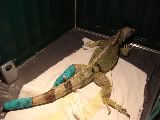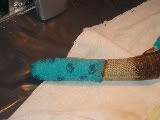As many other species of lizard, the Iguana can cast away a part of it’s tail deliberately. This is a very effective means of defending itself. After breaking off, the tail will remain to shudder in the predator’s jaws. This gives the Iguana the necessary time to flee. Skin, muscles, bloodflow, nerves and bone can detach themselves from eachother at practically every section of the tail. Losing the tail might be a natural defensive method, it remains very stressfull for the animal. The Iguana will need a lot of energy to recuperate from a snapped tail. It is important to keep the terrarium very clean. Make sure you provide sufficient food that is well balanced. Basking temperature under the lamp, and humidity need to be kept high enough, so the metabolism of the animal can work at an optimal rate.
Treatment
Prepare a hand warm bath with betadine added to it. The water is ok as soon as it has turned into a tea-like colour. The depth of the water is ok when the chest of the Iguana is submerged. Bathe the Iguana for about 15 minutes. Make sure the animal does not drink the water. Change the water if necessary, as it could be that the animal, because of the high temperature of the water, may release its . If this happens, you will have to disinfect the bathtub and the wound. After this, you can create a new betadine-bath.
Then take the Iguana out of the water and rinse the wound with straight betadine.
Attend to the wound three times a day for the following days with antibiotic ointment until the wound is completely closed and looks healthy.
As soon as there are any signs of swelling at the end of the stump or on top of it that haven’t disappeared after a week, you will want a specialised vet to take a look at it.
During the healing process, the bare muscles will fold themselves across the bare bone. This way, a hard crust will form that will protect and fortify the wound. Skin will grow over it.
Tails usually regenerate, especially with young animals, but will seldom grow to the same length and colour as it was previously. With the green Iguana, the new piece of tail will generally acquire a rubber-like and black look.
Afterwards, scabs will form, much smaller than the original ones. Most of the time these new scabs are dark brown, but they can also be sand coloured with a grainy structure. Every once in a while, the tail can be green or have green spots shining through the brown. The brown cross sections, which characterise the green Iguana, will not return onto the new tail, neither will the comb on his back.
 Partially ruptured tail
Partially ruptured tail
Sometimes a tail does not rupture entirely. Skin and muscle tissue can sometimes be ripped to the bone, while leaving the bone intact. The tail can only be saved by taking the animal to a specialised vet. The wound will have to get properly disinfected and stitched. The time between the moment of injury and the moment of stitching can never be higher than 24 hours.
When the bone is partially fractured or the stump gets infected, the tail will have to be amputated right above the fracture. A piece of bone and skin tissue will be removed s plenty of skin is left over to fold across the stump. By stitching this will be fixed. This method reduces the risk of infection and. No new tail will form after this procedure.
 After treatment
After treatment
Make sure that after the treatment feeding and surroundings of the animal are optimalised without disturbance of other animals or people.
This will contribute to a fast healing process without complications.
The air temperature in the terrarium can be around 28 or 30 degrees C (under the basking light higher ofcourse, the usual 35-40°C The night temperature must be around 26° C. Under normal circumstances these animals can cope with temperatures of 23 ° C but when an animal is sick or has to recover from an operation, you will strive for optimal temperatures for its species.
A good balanced diet is of the utmost importance. Eating disturbances can cause hypoproteina (lack of proteins) and hypocalcaemia (lack of potassium).
During the healing process it is also important that the terrarium is kept as clean as possible to avoid infection of the wound. Make sure that during this time, the terrarium is furnished in such a way that it is easy to keep clean and disinfect. Do mind that you do not remove the hiding places of the Iguana. The removal of hiding places will cause stress, which is very bad for the Iguana.
Author, Evert Henningheim
Bibliography:
Elliot R. Jacobson, DVM, PhD, DACZM (2003) Biology, Husbandry, and Medicine of the Green Iguana. Original edition., Krieger Publishing Company, Malabar, Florida, USA.
Melissa Kaplan Green Iguana Care collection
Source: Dr. Marja Kik, veterinarian for reptiles

